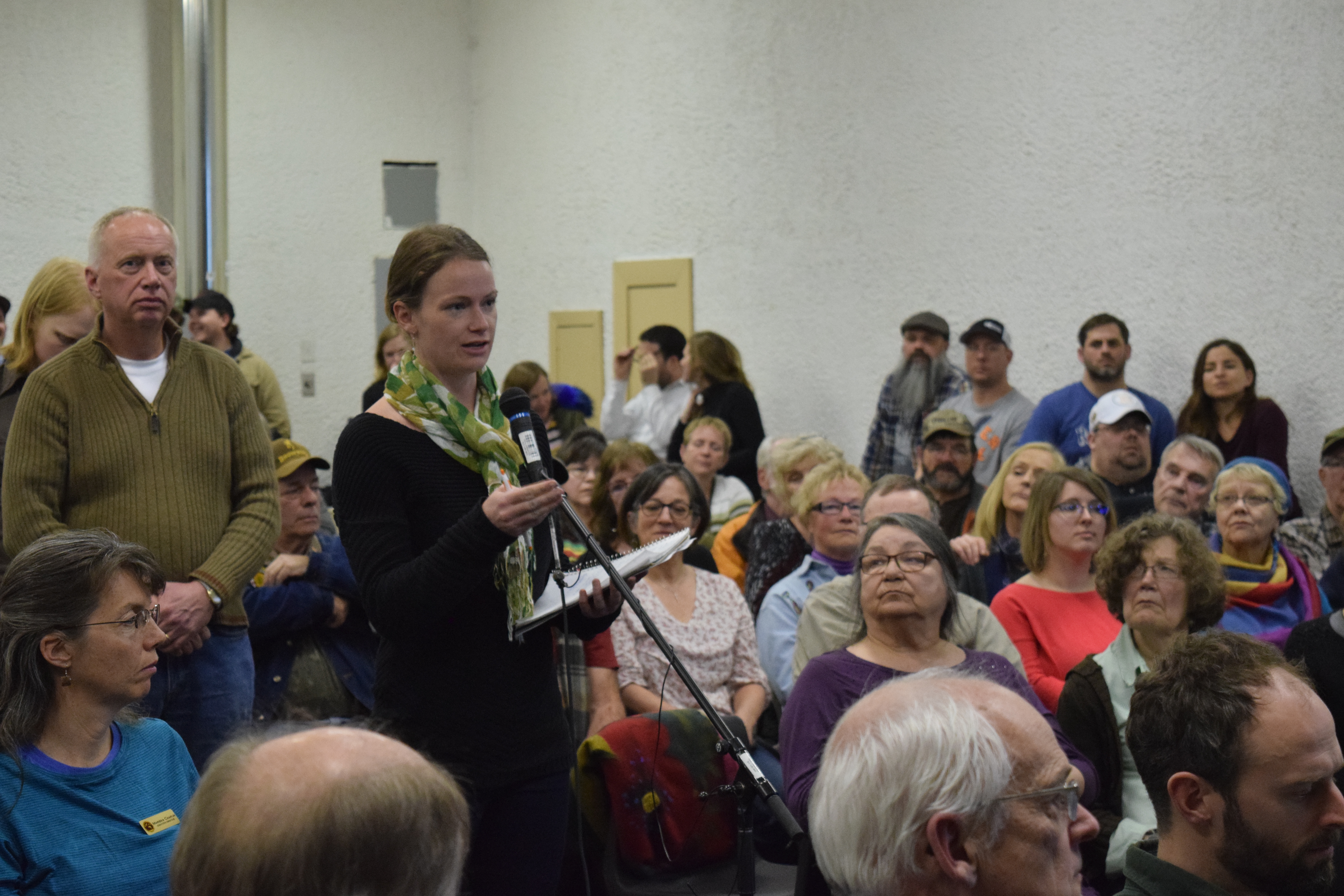‘You have no rights on our homeland or our waterways’ – Daily Gleaner – 16 March 2018
article by Adam Bowie
“People live here for the quality of life. That’s why [the idea, the promise of jobs in this area is] so important for people … so they can stay here and live here and work here and raise their families here … But if the jobs are going to impact negatively on rivers and take away the beauty of living in this space, then there’s no point in having the jobs. One negates the other.” – Amanda Wildeman, Green Candidate for Fredericton York
About 250 people jammed into the Upper Nashwaak Lions Club in Cross Creek on Thursday evening for what was at times a heated consultation session about the proposed open-pit tungsten and molybdenum mine for an area northwest of Fredericton.
Organized by the federal departments of Fisheries and Oceans and Environment and Climate Change Canada, the meeting was held to offer area citizens a chance to ask questions, or voice concerns, about Sisson Mines Ltd.’s request to replace several fish-bearing brooks with an industrial holding site for wastewater and rocks.
The mine has already been approved by the federal government, but that approval is contingent on a number of stipulations. Before it can proceed, it needs an amendment under the federal Fisheries Act’s Metal Mining Effluent Regulations. That would allow the company to cause “serious harm” to 54,400 square-metres of local fish habitat in Sisson Brook, Bird Brook, McBean Brook and the west branch of the Napadogan Brook.
To get that approval, they must demonstrate to the federal government that their plan to “offset” the loss of fish habitat – which involves installing a new culvert to restore water-flow to Nashwaak Lake – outweighs the harms.
Organizers had to add more chairs as the line of people seeking access to the room stretched out into a hallway.
The mood in the room grew heated as federal officials outlined the regulatory processes Sisson Mines Ltd. must complete in order to proceed, with many complaining about the format of the meeting and seeking more time for questions from the public. Eventually, Jacinthe Girard, head of Environment Canada’s mining and processing division, agreed to skip to the Q&A.
The first to speak was Alma Brooks, an elder from St. Mary’s First Nation, whose members have long hunted, fished and collected traditional medicines in the areas that would be affected if the mining project moves ahead.
She read a statement from Wolastoq Grand Chief Ron Tremblay, and stressed that her peoples have been using these lands and waterways for many centuries and that they’ve never ceded the lands to any government or corporation.
“You have no rights on our homeland or our waterways,” she said.
Amanda Wildeman, who lives in the Taymouth area, said she grew up in Alberta, but has fallen in love with the natural beauty of New Brunswick’s river system, particularly the Nashwaak.
People wait their turn to ask questions, or voice concerns, at a public consultation held in Cross Creek on Thursday about the proposed open-pit tungsten and molybdenum mine near Napadogan, northwest of Fredericton.
“Many people were born and raised in this area, and it’s even more special to them. But I moved here and made the choice to buy property on one of the most beautiful rivers I’d ever seen,” she said.
“People live here for the quality of life. That’s why [the idea, the promise of jobs in this area is] so important for people … so they can stay here and live here and work here and raise their families here … But if the jobs are going to impact negatively on rivers and take away the beauty of living in this space, then there’s no point in having the jobs. One negates the other.”
Experts from Stantec and Knight Piésold Consulting, who are working on behalf of Sisson Mines Ltd. on the project, offered a detailed explanation of the proposed development, its potential impacts on waterways and fish habitat, and the stringent safety measures they say are part of the proposal.
They answered questions about the type of tailings storage facility they’d like to build, and noted they’d have to maintain the site if the mine ever shuts down unexpectedly. They also assured residents that contingency plans have been drafted in case any major accidents happen.
Greg Davidson, community relations manager for the Sisson project, said there’s a good dialogue happening between the developers and members of the community.
“There were a lot of good questions, a lot of good concerns,” he said.
“It gives us an opportunity to go back to our office and continue on with our community engagement. You know, we might tweak some things”.
He said that contrary to earlier reports, he expects the mine, if approved, would need another 18-24 months before construction could begin.
“We can’t start construction until we have permits, a financial security plan in place, and detailed design work done,” he said.
Speaking after the meeting, Blaine Merrill, of Stanley, said he wasn’t convinced by what he heard.
“In fact, they convinced me to fight against them,” he said.
“That mine’s not going in. The environment is going to be safe.”
Merrill is particularly concerned about the potential impacts such a large mining project could have on the Nashwaak River. Given the low levels the waterway experienced during the summer of 2017, he’s opposed to any operation that could restrict or reduce the flow of water into the Nashwaak watershed.
“They’ve got to prove more to us,” he said. “I feel like they’re trying to buffalo us.”
